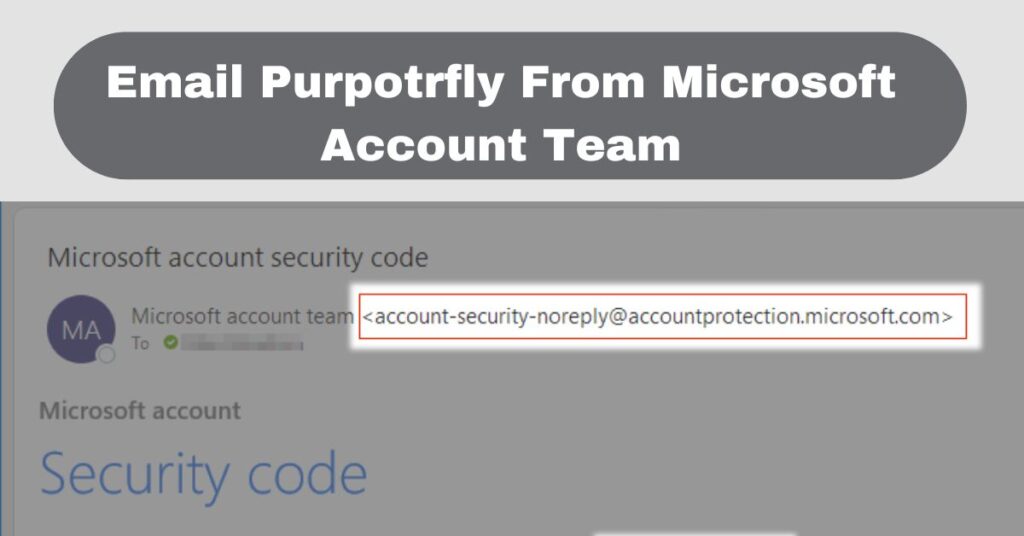Introduction
In a digital age filled with security concerns, receiving an email purportedly from the Microsoft account team may cause doubt. This article aims to clarify how to verify these emails to protect your account and sensitive information Email purpotrfly from Microsoft account team.
Why You May Receive Emails from the Microsoft Account Team
Email purpotrfly from Microsoft account team, Microsoft sends notifications to users regarding their accounts for several reasons. These notifications can include:
- Account update alerts (e.g., password changes, security updates)
- Security codes for two-step verification
- Unusual activity alerts
The Microsoft account team emails users to keep them informed and protected, especially for security updates. But knowing how to identify a legitimate Microsoft email is crucial.
Recognizing Official Microsoft Emails
A genuine email from Microsoft will come from @accountprotection.microsoft.com. Here’s how to verify if the email you received is authentic:
- Check the Sender’s Domain: Emails from the Microsoft account team will use the official domain @accountprotection.microsoft.com. Any variation or alternate domain could indicate a fraudulent message.
- Review Message Headers: By examining the email headers, you can confirm whether the email originated from Microsoft’s servers.
- Cross-Reference Email Contents: Verify that the information in the email, such as account updates or security codes, aligns with recent actions on your account.
Steps to Verify an Email Email purpotrfly from Microsoft account team
- Identify the Sender: Confirm that the sender’s email address ends with @accountprotection.microsoft.com.
- Check for Account Relevance: Ensure the email addresses the correct Microsoft account, especially if you own multiple accounts. Confirm that any codes provided were requested by you.
- Examine the Email’s Language and Structure: Microsoft emails generally follow a specific, professional format. If an email contains grammatical errors, or unusual language, it could be fake.
Read Also: The name of the internet Arbenath
Using Message Headers to Confirm Email Authenticity
For a more technical verification, you can examine the email’s message headers. Here’s how:
- In Gmail: Open the email, click the three-dot menu in the top right corner, and select “Show Original.”
- In Outlook: Open the email, go to File > Properties, and view the “Internet headers” section.
These headers can reveal whether the message came from a Microsoft server.
Handling Unexpected Verification Codes
If you receive a Microsoft verification code that you did not request, this could mean:
- Someone accidentally entered your email when attempting to access their own account.
- Someone may be attempting unauthorized access to your account.
In either case, it is best to remain vigilant. Do not share the code or ignore security alerts. If this happens frequently, you may consider strengthening your account’s security settings.
How to Protect Yourself from Phishing Emails
- Enable Two-Factor Authentication: This adds an extra layer of security to your account, making it harder for unauthorized users to access your information.
- Regularly Update Your Passwords: Regular password updates can reduce the likelihood of unauthorized access.
- Avoid Clicking on Suspicious Links: If any email contains links or attachments, verify them before clicking, especially if you weren’t expecting an email from Microsoft.
- Monitor Account Activity: Regularly review your account activity to catch any unusual logins or actions.
Conclusion
Understanding how to verify an email purportedly from the Microsoft account team is essential for your security. By following these steps, you can better protect your account and recognize potential phishing attempts. Always verify sender domains, use two-step verification, and remain cautious with unsolicited security notifications, Email purpotrfly from Microsoft account team.
FAQs
1. What should I do if I receive an email from @accountprotection.microsoft.com but didn’t request any changes?
Check your account for unusual activity, and consider updating your password. If you continue to receive unrequested codes, reach out to Microsoft support.
2. Is @accountprotection.microsoft.com the only domain Microsoft uses for security emails?
Yes, this is the primary domain for security-related emails. Any variations should be verified carefully before trusting.
3. Can I report suspicious emails claiming to be from Microsoft?
Yes, you can report phishing emails by forwarding them to Microsoft at reportphishing@Microsoft.com.
4. How can I view the message headers in Microsoft Outlook?
In Outlook, open the email, click on File, select Properties, and view the Internet headers.
5. What steps should I take if I suspect unauthorized access to my Microsoft account?
Immediately change your password, enable two-step verification, and review recent account activity.







